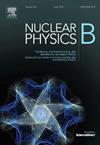允许极限曲率条件的规则黑洞周围的热力学和粒子动力学
IF 2.8
3区 物理与天体物理
Q2 PHYSICS, PARTICLES & FIELDS
引用次数: 0
摘要
本文研究了在极限曲率条件下规则黑洞的热力学和粒子动力学特征。我们首先检查一个允许极限曲率条件的规则黑洞的度规函数f(r),其中长度参数l和黑洞质量m在史瓦西度规的情况下,当l=0,为比较提供一个参考点。根据这项研究,视界越紧凑,视界半径rh随l的增加而减小。我们研究了热波动对热力学参数的影响,如霍金温度、熵和比热。通过对吉布斯自由能和能量发射率的分析,揭示了黑洞的稳定性和相变特性。我们还研究了黑洞附近的粒子运动,特别关注光子轨道,最内层稳定圆轨道(ISCO)和有效势。对轨道粒子释放的光子的红移和蓝移的分析表明,长度尺度参数l如何影响所看到的频率移。在这种情况下,我们展示了大质量粒子围绕圆形轨道的振荡,推导了相关的基本频率(准周期振荡(QPOs),并探索了各种QPO模型)。这些结果解释了在极限曲率下常规黑洞的热力学和动力学行为,揭示了它们的稳定性、相变和观测特征。本文章由计算机程序翻译,如有差异,请以英文原文为准。
Thermodynamics and particle dynamics around a regular black hole admitting the limiting curvature condition
This paper investigates the thermodynamic and particle dynamics features of a regular black hole in the case of the limiting curvature condition. We begin by examining the metric function for a regular black hole that admits a limiting curvature condition, where the length parameter l and the black hole mass M. In the case of the Schwarzschild metric when , offering a reference point for comparison. According to the study, a more compact event horizon is indicated by a drop in the horizon radius as l increases. We investigate the effects of thermal fluctuations on the thermodynamic parameters, such as the Hawking temperature, entropy, and specific heat. The Gibbs free energy and energy emission rates are also analyzed to show the black hole's stability and phase changes. We also study particle motion near the black hole, with particular attention to photon orbits, innermost stable circular orbits (ISCO), and the effective potential. Analysis of the red and blue shifts of photons released by orbiting particles shows how the length scale parameter l affects the frequency shifts that are seen. In this context, we show the oscillations of massive particles around circular orbits, deriving the fundamental frequencies associated (quasi-periodic oscillations (QPOs) and exploring various QPO models). The results explain the thermodynamic and dynamic behavior of regular black holes under limiting curvature, revealing insights into their stability, phase transitions, and observational signatures.
求助全文
通过发布文献求助,成功后即可免费获取论文全文。
去求助
来源期刊

Nuclear Physics B
物理-物理:粒子与场物理
CiteScore
5.50
自引率
7.10%
发文量
302
审稿时长
1 months
期刊介绍:
Nuclear Physics B focuses on the domain of high energy physics, quantum field theory, statistical systems, and mathematical physics, and includes four main sections: high energy physics - phenomenology, high energy physics - theory, high energy physics - experiment, and quantum field theory, statistical systems, and mathematical physics. The emphasis is on original research papers (Frontiers Articles or Full Length Articles), but Review Articles are also welcome.
 求助内容:
求助内容: 应助结果提醒方式:
应助结果提醒方式:


